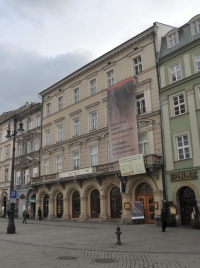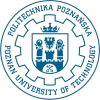Venue and the City
Venue

The 29th Picture Coding Symposium will take place in Miedzynarodowe Centrum Kultury (International Cultural Centre), in the Main Market Square, just in the centre of Medievel quarter of the city of Krakow. The most important historic places, museums and monuments of Krakow can be reached on foot from the conference venue.
Tourist information can be found here.
The city
Krakow is the second largest Polish city and the former capital of Poland. It is one of the most popular tourist destinations in Poland, with more than 7 million visitors each year.
Contrary to most of Polish cities it was only moderately damaged during the Second World War, preserving the most of its historical buildings. Its center keeping the charm of an old and ever important mid-European city is included on the UNESCO list of World Heritage.
Thanks to many universities and cultural establishments, Krakow is a city of great importance to Polish culture and history. The first Polish university was founded in Krakow in 1364 and is now known as Jagiellonian University (Uniwersytet Jagiellonski). Along with Warsaw, Krakow is the main cultural center of Poland, hosting many famous theaters, museums and other cultural institutions. The royal castle in Krakow - Wawel, home to many Polish kings, has been a place of burial of Polish heads of the State up to these days.
The historic city of Krakow offers a wide selection of places and things worth seeing. Here is a list of the most important ones:
Main Market Square
In majority of cases, the sightseeing of Krakow starts here. It is the one of the largest squares in Europe, set out in 1257 when the city received a foundation character. Just as centuries ago, with its cosmopolitan atmosphere, the Main Market Square is a favourite meeting place of the inhabitants of Krakow and guests. In its centre, there is the Cloth Hall (Sukiennice), well preserved cloth warehouses. The Cloth Hall, modernized a number of times, amazes with its Renaissance attic adorned with mascarons and a characteristic attic. Today, the Cloth Hall houses the Gallery of Polish 19th Century Painting and Sculpture, as well as booths with folk art and artistic handicraft.
Church of St Mary
The church is the largest and the second most important (after the Royal Wawel Cathedral) temple in Krakow. From the higher Tower (known as the bugle-call Tower), the bugler plays the melody of the bugle call every hour to the four cardinal points. It is a part of the city tradition and one of its symbols. This is the only musical signal in the world that has been regularly played every hour for six hundred years. According to the legend, during a Tatar invasion in 1241, the attacker's arrow shot through the throat of the municiple guard - bugler, thence the melody is broken off mid-note. The interiors of St Mary's Church has multiple valuable treasures, including the altar sculpted by Nuremburg master Veit Stoss, which is the greatest poliptych in the world, which means the greatest achievement of the art of woodcarving in Europe at the end of Middle Ages.
The Wawel Castle
The Wawel Castle, erected at the rocky limestone hill at the bend of the Vistula river, is without doubt the greatest attraction of Krakow. It is the historic seat of the Polish rulers, the place of their crowning and burial. In the castle, it is possible to see the royal chambers and regalia of the Polish rulers, a unique collection of Flemish arrases, extensive collections of Oriental art and militaria. In the vaults, there are tombs of national heroes and famous poets, including Tadeusz Kosciuszko, Adam Mickiewicz and Juliusz Slowacki. At the Sigismund Tower, in the northern part of the Wawel Cathedral, it is possible to see the most famous Polish bell, weighing 11 tons, named after its founder, Kind Sigismund the Old. Tolling of this bell marks most important events in the life of Poland; Sigismund resounded for example on Poland's accession to the European Union and on the day when John Paul II, the pope, died.
The Barbican
The fortress, built in 1498-1499 at the most northern outpost of the city fortifications, is an example of the highest standard of the art of defence. It has a diameter of 24.4 m, and its walls are more than 3 metres thick. The Gothic structure was surrounded by a moat, 3.4 metres wide. A long neck linked the Barbican with the Florianska Gate, serving as a defensive outpost. Throughout the centuries, the Krakow Barbican was also the Gate of Glory. Royal processions passed through its gate during visits of papal legates, foreign envoys and military leaders. It was the route of victorious armies, but also of funeral processions of kings and national heroes.
The Jagiellonian University
The Studium Generale, first Polish university was founded in 1364 by King Kazimierz the Great. The Krakow school, reffered to in the documents as "the pearl of the prevailing sciences" is the second oldest university in this part of Europe, after Prague's university. Krakow's University has lasted for over six hundred years at the same location. The Collegium Maius of this University is ranked among the oldest Medieval university buildings in Europe. Today one can see unique scientific instruments and other interesting artefacts here. Among the numerous scientific instruments documenting the development of human thought and science in the Collegium Maius collection, a special place is held by a globe, known as "the Jagiellonian Globe", manufactured in 1508, serving for the determination of astronomical co-ordinates. It was the first such globe showing the newly discovered land - America.
The museums of Krakow
Krakow is one of the richest Central European cities as far as museum collections are concerned. There are over 40 museums in Krakow. Their exhibits include such true pearls as: Lady with Ermine by Leonardo da Vinci and Landscape with the Good Samaritan by Rembrandt. The three most popular museums are: Princes Czartoryski Museum, Collegium Maius Museum (the Jagiellonian University) and Stanislaw Wyspianski Museum (Polish art of the turn of the 19th and 20th century).
 |  |  |  |  |  |
